Martial Arts: Steve's Story
Martial Arts:
Steve's Story
- Timeline
- People
- Schools
- Organizations
Martial Arts have been an enormous part of my life. I share my experience with images and prose. I hope you enjoy reading these stories them as much as I have enjoyed writing them.
This is a long term project that I estimate is half completed.
Now that many years have passed since I began this project, it seems unlikely that I will ever finish, so ... please send me your ideas, whether they be additions, corrections, or suggestions to me at: my-first-name [at-sign] hellers [dot] ws. One of the nicest aspects of this project is that I've gotten in touch with old friends, met new people, and even connected together people I did not know.
 My martial arts training started at age six or so when my dad took me to Judo class at the Poughkeepsie JCC. The instructor, Fred Margolis, ran a pretty good size club, and we took lessons for about a year until Fred moved away and the club folded. I rose to the rank of yellow belt (I don't think dad took any promotion tests) and still recall basic Judo history. At the promotion test pictured here, I'm the fellow with the shortest hair in the middle of the front row.
My martial arts training started at age six or so when my dad took me to Judo class at the Poughkeepsie JCC. The instructor, Fred Margolis, ran a pretty good size club, and we took lessons for about a year until Fred moved away and the club folded. I rose to the rank of yellow belt (I don't think dad took any promotion tests) and still recall basic Judo history. At the promotion test pictured here, I'm the fellow with the shortest hair in the middle of the front row.
 In Junior High School I wrestled for three years. Realizing that I wouldn't be wrestling in High School, I looked for another activity. My good friend Tom Scribner had been taking Tae Kwon Do lessons from Tony Rozario in downtown Poughkeepsie. After watching a class and Tom's green belt test, I was hooked. It turned out that Tony, who was very good, had broken away from the organization I eventually joined, the WTKDA. Tony's group was called Tri-County Tae Kwon Do, as I recall. This photo is from November 1990, when Tony hosted a tournament in Poughkeepsie. From right to left are a silly Mark Miller, Joe Mansfield, Bob Dvorkin, Tony, and I.
In Junior High School I wrestled for three years. Realizing that I wouldn't be wrestling in High School, I looked for another activity. My good friend Tom Scribner had been taking Tae Kwon Do lessons from Tony Rozario in downtown Poughkeepsie. After watching a class and Tom's green belt test, I was hooked. It turned out that Tony, who was very good, had broken away from the organization I eventually joined, the WTKDA. Tony's group was called Tri-County Tae Kwon Do, as I recall. This photo is from November 1990, when Tony hosted a tournament in Poughkeepsie. From right to left are a silly Mark Miller, Joe Mansfield, Bob Dvorkin, Tony, and I.
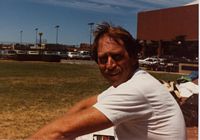
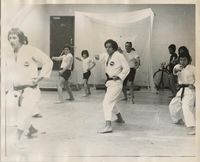
 Just at that time (March of 1975), Bob Dvorkin started a class at the JCC, and my dad (middle image, back-row center) and I (middle image, back-row left) both began attending Sunday mornings in a matted room called the exercise room. Bob was a brown belt (he soon rose to black belt), and we were a collection of white belts with one upper belt, Bernie Cohen (a yellow belt, right image, right), with occasional visits from siblings Carol (top image, right) and Mark (right image, center) Solomon, purple and yellow belts respectively.
Just at that time (March of 1975), Bob Dvorkin started a class at the JCC, and my dad (middle image, back-row center) and I (middle image, back-row left) both began attending Sunday mornings in a matted room called the exercise room. Bob was a brown belt (he soon rose to black belt), and we were a collection of white belts with one upper belt, Bernie Cohen (a yellow belt, right image, right), with occasional visits from siblings Carol (top image, right) and Mark (right image, center) Solomon, purple and yellow belts respectively.
It was about a year before Bob sent any of us for promotion. Four of us kids (Matt - right image, back row center), Hugh (right image, back row left), another fellow, and I) went to see Grandmaster Duk Sung Son, founder and president of the WTKDA, our association, and we received yellow belts. The next class, Bob taught us to break a 10"x12"x1" pine board with a knife-hand strike. Learning to break a board this way after becoming a yellow belt became a tradition in our class. Dad was promoted to yellow belt soon after. Breaking a board was the apex of his martial arts career, and he retired from martial arts.
Bob is quite a skilled martial artist and charismatic teacher, and the club grew and grew. We outgrew the exercise room, practicing for a while in the auditorium, and eventually occupying the gym each Tuesday, Thursday, and Sunday evening for many years. A separate kids class was established, taught initially by Ralph and Marian Schwartz, and then taught for many years by John Jackson and Sandy Hildibrand. The main class often had fifty to seventy participants and was a vibrant athletic and social community. The first black belt to be promoted from the JCC class was a fellow named Ron Lucier, who retired from class soon after.
One night a week class was taught by Dan Fitzgerald. I have fond memories of learning from school teacher upperclassmen Larry McGill and Jan and Don Egry. The next generation of teachers were being trained, including Giles Hopkins, George Robinson, Michelle Brotman, Chuck Brotman, Mark Miller, Doug and Matt Wattoff, and me, along with many others. We always went to dinner after class; everyone in class was invited.
Dan Fitzgerald was sometimes referred to as second-dan Dan, for there was also a first-dan Dan, Danny Mearns, a frequent visitor to class. Danny (first-dan Dan) was a powerhouse. He eventually wandered off to Cornell and then UCSB where he received a PhD in theoretical physics and where he started the TKD Club at UCSB. I believe that Danny eventually was promoted to fourth dan, completely destroying our old naming convention.
I liked breaking boards. After I started getting summer jobs in the late seventies, I found that I could afford to buy large quantities of wood to smash to bits. At that time, number three pine cost about a quarter a foot. I recall collecting orders for about six hundred and fifty linear feet of pine shelving (1"x12"). Danny had a table saw at his parents' house, and we spent the greater part of a day cutting over seven hundred ten inch pieces. I was in for over a hundred pieces, which I brought to class, thirty or forty at a time.
Eventually George Robinson and Chuck Brotman taught classes for Bob on a regular basis. Thursday night had split sessions, with Bob teaching an upper belt class.
Bob sought techniques to expand the program. A set of techniques that we called "advanced basics" included back side kick spinning fist (double fist on the return), crescent kicks (inside and outside), front kick followed by triple-punch, thirty-degree kick (short instep crescent kick), sweep and fake sweep hook kicks, low high round house kick.
The Mid-Hudson Valley and the greater Poughkeepsie area was a stronghold for the WTKDA, and there were a number of large clubs.
 The IBM Country Club class was established by Master K. C. Park, Mr. Son's student. An IBM executive, Dr. Park taught before I began studying TKD. By the time I was on the scene, a Saturday morning class was taught by the senior student in the Hudson Valley, Mike Teck, later to be assisted by his son Scott. Mike worked at the IBM Country Club and was an inspiration and a role model in humility, civility, and caring. Mike reached the rank of fifth dan.
The IBM Country Club class was established by Master K. C. Park, Mr. Son's student. An IBM executive, Dr. Park taught before I began studying TKD. By the time I was on the scene, a Saturday morning class was taught by the senior student in the Hudson Valley, Mike Teck, later to be assisted by his son Scott. Mike worked at the IBM Country Club and was an inspiration and a role model in humility, civility, and caring. Mike reached the rank of fifth dan.
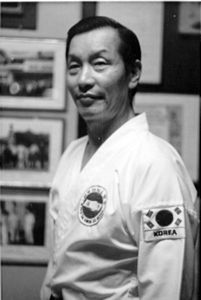 The Wednesday night class at the IBM Country Club was taught by Mr. Son, who made a train or bus trip up from NYC every week. All the area instructors and most other black belts attended this class as well as brown belts preparing for promotion. There were also some colored belts. Promotion tests for all colored belts from all the clubs in the area were held each week during class. After class, black belts went out for a drink and then dinner, for many years at the Milanese Restaurant. Mr. Son was fairly comfortable in this setting, and often told stories. A curious youngster, I was an eager listener. The greatest lesson I took from Mr. Son was not TKD technique, but never to speak poorly of anyone. I still strive to this ideal.
The Wednesday night class at the IBM Country Club was taught by Mr. Son, who made a train or bus trip up from NYC every week. All the area instructors and most other black belts attended this class as well as brown belts preparing for promotion. There were also some colored belts. Promotion tests for all colored belts from all the clubs in the area were held each week during class. After class, black belts went out for a drink and then dinner, for many years at the Milanese Restaurant. Mr. Son was fairly comfortable in this setting, and often told stories. A curious youngster, I was an eager listener. The greatest lesson I took from Mr. Son was not TKD technique, but never to speak poorly of anyone. I still strive to this ideal.
Anywhere from ten to twenty-five black-belts went out to dinner every Wednesday night after class at IBM. One fellow, Artie Lichtman, liked to tell jokes. Artie's attempts at levity were always appreciated, even when the audience didn't agree with his sense of humor, leading to the phrase, "Wednesday night joke."

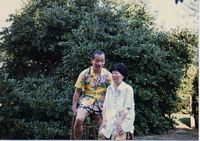 19 June 1987. The Hudson Valley WTKDA black belt picnic was hosted at the home of Michelle Brotman's friend Viv Petrovitz. Viv is seated wearing a peach blouse.
Mr. and Mrs. Son both attended the picnic that year.
19 June 1987. The Hudson Valley WTKDA black belt picnic was hosted at the home of Michelle Brotman's friend Viv Petrovitz. Viv is seated wearing a peach blouse.
Mr. and Mrs. Son both attended the picnic that year.
The class at the Poughkeepsie Middle School was taught for many years by Cal Russell, who had a gruff exterior and a soft spoken core. After Cal retired from TKD at a rank of fourth degree, the class was taught for the next many years by Pete Michaelson, an energetic ex-Marine hunk of muscle who gave endlessly of himself to the larger community. After Pete left the WTKDA, I believe the class was taken over by Joe Polestina.
Tommy Douglas taught class at the Storm King School, where WTKDA summer black belt camp found its home starting in 1991. Tommy, a police officer, was a brick house, and could break more boards with a side kick than you can imagine (thirteen, I believe).
Keith Lipsey taught a class in Newburgh (and other places), and was Bob's sparring buddy. Both excellent fighters, it was not unusual for Keith and Bob to meet in tournament finals. Keith was fast, had long legs, and was extremely flexible.
Ralph Rubino taught a class at Vassar College and a class at the YWCA. Several of his Vassar students ended up practicing at MIT, including Joel Doolin, Charlie Ginsberg, and AJ Lubia.
Our club at the JCC branched out as the next generation moved away. Giles Hopkins began a club in Northampton, Mark Miller at Tufts and later Tenefly, NJ. Michelle Brotman and Mark Solomon started a club in Milbrook that Chuck Brotman ran for a number of years after IBM sent Mark to Germany.
During the summer of 1977, I attended Cornell Summer, a six week High School program at Cornell. I had an opportunity to practice for three weeks with Phil Zaneteas, who was welcoming, strong, and a man of few words. Phil went on to become an MD and a PhD.
I wandered off to MIT in the fall of 1978 a brown belt, and I took my black belt test that December. I took the train from Boston to to NYC for an evening test. We went out to dinner, and I planned to take the next train home whenever I got to Grand Central Station; trains ran every few hours. It was a long evening; I got to Grand Central just in time to miss the 1:20am train, and the next one was scheduled to leave at 3:20am. I was exhausted, so I wandered around just trying to keep awake. I remember looking up at a digital clock that flipped every minute to a new time. As I watched it flip to 2am, it started flipping again, and stopped at 1am. I couldn't believe my eyes; I was in the twilight zone. In 1978, clocks were not adjusted in the fall as usual. In fact, clocks were set back the night of my black belt test, much to my surprise. I don't know how I made it to the next train which operated on the new clock setting.
At this point, I made a strategic mistake. There was a TKD club at MIT, taught by MIT undergrad Chung Sun Kang, a fifth degree black belt son of a Korean master, Suh Chong Kang. I attended one class in the fall of 1978. Chung Sun was an extremely skilled practitioner, and a very nice fellow. I mentioned him to Mr. Son, who knew the senior Kang (they were classmates together under Won Kuk Lee), and Mr. Son directed me not to practice with Chung Sun, but to start a WTKDA club. By letting politics get in the way of my education, I missed the opportunity to learn from several excellent instructors and practice with many talented students.
In the fall of 1979, Jon Daurio, a second degree black belt, matriculated at Harvard and started the Harvard-Radcliffe Korean Karate Club. The following January (1980), Mark Miller came over from Tufts to help me put on a demo in a room at the MIT gym called the T-Club lounge. That was the beginning of the MIT Korean Karate Club. Mark came to class sometimes; I had essentially three steady students, Mark Lazan, Laura Goldberg, and Kumar Nochur. In the spring we held an outside demonstration at MIT on East Campus.
3 May 1980: our first demo, at McDermott Court, East Campus, MIT. Mark Miller and the Harvard crew joined us. Laura Goldberg and Mark Lazan are demonstrating three step sparring. In the image on the right, Mark Miller captured the last of four stations in my combination break. Jim Corona, a yellow belt, is holding the board for my left foot. John Daurio is holding broken boards from the third station and toughening his foot.
MIT Korean Karate Club membership waxed and waned through the first few years (mostly waned). Peter Carmichael joined class in the Fall of 1980, and dragged along fellow Bakerite Alex Storrs in the Spring. For one semester Alex couldn't attend the scheduled class, so he and I had mini-classes in various open spaces in Baker House. Peter Lawless and Susan Lichtman, Poughkeepsie transplants from Bob's class and Cal's class (I think), participated starting in the spring of 1982. Various others dropped in and out of class.
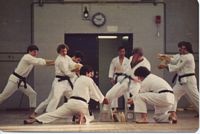 In 1981 we had our first large demonstration with Mr. Son at the Walker Memorial gym at MIT. The crew came in from Poughkeepsie.
In 1981 we had our first large demonstration with Mr. Son at the Walker Memorial gym at MIT. The crew came in from Poughkeepsie.
In this photo: Bob just completed a combination break. From left to right: Phil Grecco,
John Jackson,
Mike Goldstein,
Mark Miller,
Mr. Son,
Bob Dvorkin,
Steve Heller,
Giles Hopkins, and
George Robinson.
Stu Rosenfeld, a second degree black belt who had trained at Brown, came to watch this demo. Stu was a professor at Wellesley, and he soon joined class, practicing until he moved away in the spring of 1982.
Mr. Son came to MIT every year or two for a large demonstration and a promotion test. I heard an interesting story about Chung Sun Kang, the instructor of the MIT TKD Club (the other TKD club), just before Mr. Son came to town. One of Chung Sun's students asked him if he should go to our demo, and Chung Sun told him that of course he should go; Mr. Son is a master. No politics.
Each summer starting the summer before college until the summer after getting my master's in 1983, I worked at IBM in Poughkeepsie, so the MIT club closed for the summer. This gave me opportunities to continue to practice with Bob and the old gang. By this time, Bob called the club the Community Tae Kwon Do Club (CTKDC). From June of 1982 until January of 1983, the MIT club shut down for eight months during my coop assignment.
When I returned to school in January, 1983, Mark and Laura were still interested in practicing. Mark took his brown belt test on a road trip to Poughkeepsie late in the spring of 1983 just before he graduated and moved to CA.
In the fall of 1983, Mark had moved away, and Laura practiced for one more semester. Fortunately, Rob Swiston, a student from my High School in Poughkeepsie and a student from Bob's class at the JCC, came to MIT. He brought Jay Cohan and Chris Young, a couple of friends from Baker House, with him to class. Gene Cohen, also from Baker House, joined class in January. Jay, Gene, and Chris eventually recruited a large number of Bakerites to fill out the ranks of the club in the mid eighties.
When Jon Daurio graduated from Harvard in 1982, Tom Kraluski led the club for the next year. Then Mark Spaulding, a grad student in History, led the club 1983-1985. Irwin Jungreis and Peter Everett moved to town from Cornell as brown belts in the fall of 1983, and they joined the Harvard club (Irwin was a grad student in math). Peter and Irwin came to class often at MIT starting in December of 1983; I think they trained eight days a week in preparation for their black-belt test. Mark spent a year of grad school (85-86) in Germany during which time Irwin and Peter ran the club. Upon Mark's return to Harvard for a year or two to finish his PhD, Mark, Irwin, and Peter shared club leadership. When Mark moved on, Irwin and Peter continued to lead the club for a number of years, and then Peter led until around 2001.
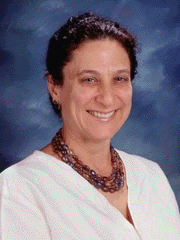 Cynthia Dwork came to MIT for a post-doc in the summer of 1983. Her TKD training started at Princeton, and continued at Cornell. She arrived in Boston with her first degree, and initially she practiced with the other TKD club. She also practiced with us (eventually exclusively), and she and I were next promoted the same day, on 25 May 1985. Cynthia was energetic, flexible, and a great asset to our club. While Cynthia was at MIT, we had two classes a week, and Cynthia taught half the classes. Cynthia moved to CA in 198? and practiced with the Mountain View School of TKD for a few years, where she rose to the rank of third degree.
Cynthia Dwork came to MIT for a post-doc in the summer of 1983. Her TKD training started at Princeton, and continued at Cornell. She arrived in Boston with her first degree, and initially she practiced with the other TKD club. She also practiced with us (eventually exclusively), and she and I were next promoted the same day, on 25 May 1985. Cynthia was energetic, flexible, and a great asset to our club. While Cynthia was at MIT, we had two classes a week, and Cynthia taught half the classes. Cynthia moved to CA in 198? and practiced with the Mountain View School of TKD for a few years, where she rose to the rank of third degree.
Bob required all his students to qualify for testing with Mr. Son by completing a pre-test with him. This was a much more involved exam offering ample opportunity for feedback on everything the student had studied. Although a great tool for feedback, it became impractical for Bob to personally oversee pretests at a distance as the MIT club grew. Bob was quite generous with his time in supporting the MIT club.


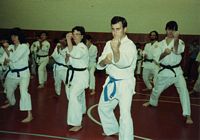
On 24 January of 1984, I organized a half-day workshop of nine MIT martial arts clubs. It was a pleasure to hear what each one had to say to help fellow martial artists understand how they were different. Not only were there two active Tae Kwon Do Clubs at MIT, but two Shotokan clubs, and two Wu Tang Kung Fu clubs. In the first image, I am leading Mark Spaulding and Cynthia through first-degree form Ship-Su, and in the second image, I am demonstrating double arm block, a technique I had not seen in other styles. In the third image, Peter Everett is helping demonstrate as the workshop tries this technique.
| Club | Instructor
|
|---|
| Boston Wu Tang
| Master Leung Kay Chi
|
| MIT Judo Club
| Andrew K. Joseph, 2nd Dan
|
| Karatedo Doshinkan
| Steve Ellis, Nidan
|
| MIT Korean Karate Club
| Steve Heller, 2nd Dan
|
| MIT Shotokan Karate Club
| Joe Couto, 2nd Dan
|
| Shotokan Karate of America
| Joe Fu, 2nd Dan
|
| MIT Tae Kwon Do Club
| Anthony D'Amico, 2nd Degree
|
| MIT Wonhwa-Do
| Eijiro Kusakari, 3rd Degree
|
| MIT Wu Tang
| Mike Walco
|
At MIT I took judo as a PE class, and I learned a timing drill that I found fascinating. Two players would lock-up (use the right hand to grab the other's lapel and the left hand to grab the other's right sleeve, the standard judo lock-up), and rock from side to side, alternately unweighting their feet. One player would sweep the foot of the other player, who would cooperate. The idea is to learn when to execute a sweep. When one's weight has started to shift to a foot, but the foot has not yet touched the ground, that is the time to sweep. After ones momentum is committed and the foot is airborne, it is extremely difficult to change direction until the foot is planted and can push off.
I applied the principle of this judo drill to sparring. The defender would rock front to back, gently and rhythmically lifting alternate feet. The attacker would attack (any leg or hand attack, not usually a sweep) at various times in the rocking cycle seeking to internalize the windows of vulnerability. The same principle applies. Once one's momentum is committed, one cannot easily change direction until the foot plants, while shifting to either the front or the back foot. The lesson I learned is one of universality and openness. Principles are universal, and insights are available everywhere.
In February, 1984, Mike Even and Poh Lim started practicing. Mike and Lim went on to become instructors, and Lim eventually led the club after I stopped practicing.
When Mike and Lim earned their purple belts, it was a watershed event for the club in my eyes. Mark Lazan, a charter member of the club, reached brown belt, but at a time that the club was small and its future was uncertain. When Mike and Lim earned their purple belts, the club was strong and growing. As we sat for a two-on-one chat in the grass near Mass. Ave. outside the T-Club lounge, we talked about the opportunities and challenges of becoming an "upper belt." The techniques in forms were more involved, and the achievement was to be apprecated. I have no idea if either of them remember the event, but it was significant to me.
24 February 1985: On an unseasonably warm winter day the Harvard club joined us for a at winter practice outside. Cynthia is teaching front kicks to Lim, Susan Hardy, Gene Cohen, and others. Chris seems to have learned Cynthia's front kick.
I guess Mark Spaulding gets the credit for Jay Cohan and Lim's side kicks.
When did Jill and Mike start? "big Jill" and "little Jill"
[The Cornell invasion continues: Anne Berlin (1986), Vernon Church, Mary Theodore]
Jill Goldstein, an epidemiologist, moved to Boston from NYC where she had learned from Mr. Son. Jill arrived with a third degree, was poised and strong, and represented the HQ school well. In addition to attending class, she taught an extra split-session class we held for black belts only, much like we had at the JCC. This class was held in a basement lobby below the T-Club lounge that we nicknamed "The Secret Do-jhang."
[Mike and Lim taught class. Ian joined.]
 [Mark Weiner and Chris Dennis, a couple of Mondo-bots (more of Ray's students) joined us.]
[Mark Weiner and Chris Dennis, a couple of Mondo-bots (more of Ray's students) joined us.]
[Joel Doolin came in from Ralph Rubino's Vassar class. Charlie ... AJ]
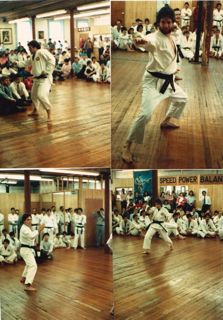
Thanks to Dave Schwartz for this photo from his parents' album. I believe it was the third degree test for Chuck Brotman, Michelle Brotman, George Robinson, and me, 5/85.
Every Fall and Spring, we recruited new club members from the MIT community. In the fall of 1985, we were practicing outside on the Kresgee lawn, and a fresman, Rosanne, stopped by to ask a couple of questions. It turned out she attended my high school. I asked her if she had ever practiced martial arts before, and she said her father, Kyu Chang Park, was a TKD teacher, but she didn't really practice. I didn't immediately connect the name to "K. C. Park" as I had known it. During the next day or so, I suspected the connection, and happened to chat with Bob Dvorkin and told him that I thought Master Park's daughter stopped by class and asked a couple of questions, but I didn't think she would join us. That set an interesting chain of event in motion. Bob mentioned something to Mr. Son on Wednesday night at the The IBM Country Club class, and subsequently Mr. Son called Dr. Park. Dr. Park in turn called Rosanne and told her he had heard that she had joined the MIT club. This game of telephone had all happened in less than a week. In the mean time, Rosanne had not returned to class. As it turns out, she had been thinking of joining the MIT club, and in fact she did. Rosanne ended up living in Baker House and practicing TKD for a semester, at which point she earned her yellow belt and retired.
On 3 November 1985, we hosted the Harvard club for a practice tournament to give students an idea of what happens at a WTKDA tournament. We had at least one more of these on 8 May 1986.
As part of the WTKDA, we participated in two tournaments a year, typically in Poughkeepsie, in NYC, or at West Point (Military Academy).
 The MIT club attended many tournaments, but the WTKDA Championships
on Oct 24, 1987 at Madison Square Garden's Felt Forum in New York City
was the best attended.
The MIT club attended many tournaments, but the WTKDA Championships
on Oct 24, 1987 at Madison Square Garden's Felt Forum in New York City
was the best attended.
Left to right: Beth Kulas, Susan Hardy, Rich Lemione,
Steve Heller,
Mike Nussbaum,
?,
Debbie Howe,
Christos Kaklamanis,
Mike Conboy,
Ian Taylor,
Won Suk Cho, Chris Young,
Poh Lim,
Dave Jesurum,
Gene Cohen,
and Dave Mayes.
Also Participating:
Mike Even,
Jill Damashek,
Peter Lawless, Rick Renwick, Toai Doan, and Stan Oda.

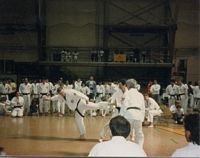 The highlight of my fighting career was during a tournament at West Point when I scored a point on Ted Hillson, an extremely accomplished martial artist and a dear friend. Michael Dealy was the referee, and Lenny Carlson is the judge on the right.
The highlight of my fighting career was during a tournament at West Point when I scored a point on Ted Hillson, an extremely accomplished martial artist and a dear friend. Michael Dealy was the referee, and Lenny Carlson is the judge on the right.
May 22, 1987.
Dear Stevie,
My collection of pictures like this is growing all too large.
My students are irreverent with my camera. Requests for the negative, enlargements, etc., will be met, although grudgingly.
I'll try to get in touch this summer. Take care, Ted
WTKDA black-belt tests were held twice a year, usually in NYC. Candidates demonstrated their skill by performing in four areas: forms, freestyle sparring, three/one-step sparring, and board breaking. First and second degree candidates performed the forms at their level, and third (and I think fourth) degree candidates performed all forms. Third degree and up candidates performed two-on-one or three-on-one sparring. First degree candidates were required to break three boards (1x10x12 pine in a pile with no spacers) one way; the most popular technique was a side kick. Second degree candidates were required to break four boards (1x10x12 pine) two different ways. Third degree candidates were required to break five boards (1x10x12 pine) three different ways. Fourth degree candidates did a combination break of their choice. As a fairly big and strong guy, this was always the least of my worries. I don't recall if the fifth degree tests had specific requirements, and I don't think sixth degree had tests, per se.
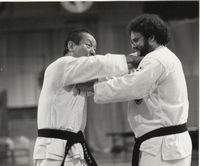 Mr. Son came to Boston once or twice a year to conduct a colored-belt promotion test and a demo . On one occasion I had the opportunity to be Mr. Son's three-step sparring partner. "Some bad boy," I'm attempting to grab Mr. Son, and he is taking me out.
Mr. Son came to Boston once or twice a year to conduct a colored-belt promotion test and a demo . On one occasion I had the opportunity to be Mr. Son's three-step sparring partner. "Some bad boy," I'm attempting to grab Mr. Son, and he is taking me out.
During the mid and late eighties, there were a large number of WTKDA clubs and black belts in the greater Boston area: Harvard, Tufts, Clark, Narragansett, Cranston RI, and MIT. I organized a list of names and addresses I called BABBs (Boston Area Black Belts) to encourage communication, and I started writing a newsletter, BABBS Blabs, listing practice times and schedules for association events. For a while, we got together to work out every few months to commune and exchange ideas for teaching. I have files of BABBS Blabs that I sent between 1988 and 1993, but the 1988 letter was clearly not the first one. They contain an interesting record of the comings and goings in the Boston Area.
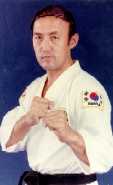 Newsletters were not without precedent. Master Dong Hoon Kim from Tucson published "The West Coast Blue Wave." Early issues were subtitled, "W.T.A. West Coast Regional Newsletter," but more recent online issues, "Newsletter of the Tae Kwon Do Chung Do Kwan Schools" (Winter 1988, and June 2002).
Newsletters were not without precedent. Master Dong Hoon Kim from Tucson published "The West Coast Blue Wave." Early issues were subtitled, "W.T.A. West Coast Regional Newsletter," but more recent online issues, "Newsletter of the Tae Kwon Do Chung Do Kwan Schools" (Winter 1988, and June 2002).
Peter and Irwin published an introductory edition of "Tae Kwon Do Focus" which was less a newsletter and more an introduction to class. "Reading about it is no substitute for doing it." There was also a Volume I, Number 1, edited by Peter.
Chuck's letter in Poughkeepsie.
In an open letter dated 14 February 1995 to all WTKDA schools on the subject of "newsletters," Mr. Son stated that newsletters within a school were appropriate, but regional newsletters were "neither welcomed nor accepted." Explanations were given. The newsletter I had been publishing was designed to build the local community. Although I had no evidence the Mr. Son's letter was directed particularly at me, my efforts were clearly unwelcome, so I backed off.
 During the late eighties, I took the opportunity to travel to some WTKDA tournaments in the mid west. In 1988, Gene Cohen, Chris Young, and I visited Master K. H. Kim in Omaha where we hooked up with Alice Bedoyan from the Mountain View Cub.
Gene and I arrived a little early and attended class on Friday, the day before the tournament, a class taught by Puht Dek, an extremely talented practitioner. At the beginning of class he joked with the students that if they weren't already in shape, they would be in shape by the end of class. After class, Mr. Dek practiced a breaking technique for the next day, a flying split kick (simultaneous side kick to the right and inverted roundhouse to the left) followed immediately by a right side kick before reaching the ground.
During the late eighties, I took the opportunity to travel to some WTKDA tournaments in the mid west. In 1988, Gene Cohen, Chris Young, and I visited Master K. H. Kim in Omaha where we hooked up with Alice Bedoyan from the Mountain View Cub.
Gene and I arrived a little early and attended class on Friday, the day before the tournament, a class taught by Puht Dek, an extremely talented practitioner. At the beginning of class he joked with the students that if they weren't already in shape, they would be in shape by the end of class. After class, Mr. Dek practiced a breaking technique for the next day, a flying split kick (simultaneous side kick to the right and inverted roundhouse to the left) followed immediately by a right side kick before reaching the ground.

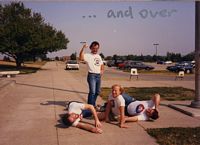 At the tournament in Omaha, we met the instructor from the Red Centre TKD Club from Alice Springs, Australia. This fellow was very nice, very strong, and very good at defending himself. In the tournament, he didn't attack much at all, but it didn't appear as though anyone scored a single point on him. On the street, when Gene, Chris, and I attacked him, he took us out!
At the tournament in Omaha, we met the instructor from the Red Centre TKD Club from Alice Springs, Australia. This fellow was very nice, very strong, and very good at defending himself. In the tournament, he didn't attack much at all, but it didn't appear as though anyone scored a single point on him. On the street, when Gene, Chris, and I attacked him, he took us out!
I visited Mr. Kim in Tucson and attended the WTKDA tournaments early in 1989 and 1990. Mr. Kim, Gerry Bates, and the gang in Tucson were very welcoming. I returned to Tucson the next year with Debbie. The California clubs, especially the Mountain View club attended mid-west tournaments, and it was always a pleasure to meet Bob Hodges, Alice Bedoyan, and others there.
Over the years, as the club grew and shrank, we found a number of places to practice. Initially, the club practiced Sunday mornings, 9-11am in the T-Club Lounge, much like the early days in the exercise room at the JCC class. For the first semester, we met once a week, and we usually had 2-4 people in class including me. During the fall of 1980, we started meeting twice a week, possibly at that point expanding to the Dance Studio, the room over the T-Club Lounge for a mid week evening practice. Alex Storrs and I crashed the Baker House dining room for a semester.
By the spring of 1984, we were in expansion mode. Rob Swiston and Cynthia Dwork had arrived in 1983, and Rob brought Jay Cohan and Chris Young to class. Jay and Chris brought Gene Cohen to class, and the three of them began a Baker House recruitment drive over the next few semesters that grew the club significantly. We added a third class in the third floor lobby of Building 34. Mike Even, and
Lim started practicing along with Gene.
In parallel with the Baker House expansion, Jill Damashek brought all sorts of people not strictly from the MIT community to class. [Add more here after checking in with Jill.]
Starting in the summer of 198?, class became a year round thing as we began practicing outside in the summer, usually on the Kresgee lawn, and under the Athletic center overhang in the rain. As black belts moved to town and we started growing our own, we started a black-belt cless on Thursday nights taught by Jill Goldstein in parallel with regular class. Black-belt class was conducted in a lobby below the T-Club Lounge, in the gym basement in an area we referred to as "the secret dojhang."
[fill out places and class sizes...]
[talk about Kuk-Mu 3-5 and Chul-Gi 3 and the "Red Book."]
[Teaching MIT PE class.]
Weebuls, toe-position sit ups, and other such madness.
[Eddy Tan, Peter Howe ... others]
It must have been in the late 80s that Ian Taylor and I attended a jujitsu seminar in the Boston area offered by Professor Wally Jay in Small Circle JujitsuTM. We spent a day learning to use little motions to cause large amounts of pain. It was interesting to learn about something so unlike what we regularly practiced.
During the summer, we had class outside on the Kresgee lawn. We hung a heavy bag from a tree, and had enough room for forty or so of each basic technique before turning around. I made up a drill called "Kick Steve across the lawn" in which I held an air shield (an inflated kicking target the size of a bread box). The class lined up in front of me and took turns kicking the shield and me as hard as they could, attempting to drive me backward from one side of the lawn to the other. Peter Everett was not allowed to participate nor was Ian Taylor using his right leg, for these attacks would hurt me.

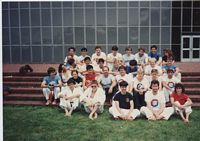 From 1985 to 1991 we had seven weekend summer camps at MIT. We practiced a couple of hours Friday night, four hours each Saturday morning and afternoon, and three hours Sunday morning, a total of thirteen hours in the sun. Guest instructors usually included Bob Dvorkin and Mark Miller, and occasionally Chuck Brotman and Ted Hillson.
From 1985 to 1991 we had seven weekend summer camps at MIT. We practiced a couple of hours Friday night, four hours each Saturday morning and afternoon, and three hours Sunday morning, a total of thirteen hours in the sun. Guest instructors usually included Bob Dvorkin and Mark Miller, and occasionally Chuck Brotman and Ted Hillson.
During the summer of 1989, Mark Miller attended summer camp at MIT as he usually did. Mark mentioned that I probably knew one of his recent students, Debbie, from Poughkeepsie. It turned out that I did know her, and she was my wife. Wait a minute. I had better get the sequence straight when I rewrite this story. Shortly thereafter, Mark invited me to come to NJ to help him run a little tournament, and I did. Mark and I often went out of our way to help each other.
 May 1990: TKD in Caracas. Mr. Son brought a group to help run a tournament in Caracas. It was a whirlwind trip, fifty hours from taking off until landing back in New York City. Upon arriving Friday afternoon in Caracas, we went straight to the beach. We had practice early for two mornings, with the tournament on Saturday. Saturday night we went out Salsa dancing, and we consumed large quantities of steak.
May 1990: TKD in Caracas. Mr. Son brought a group to help run a tournament in Caracas. It was a whirlwind trip, fifty hours from taking off until landing back in New York City. Upon arriving Friday afternoon in Caracas, we went straight to the beach. We had practice early for two mornings, with the tournament on Saturday. Saturday night we went out Salsa dancing, and we consumed large quantities of steak.

 Bob and Ted started holding fall camps beginning in 1988, and as of 2005, they are planning their eighteenth camp. It is multicultural education in the woods. The left image is the group at the second fall camp in 1989. The right image captures one year's instructors: Joe Mansfield, Keith Lipsey, Ted Hillson, Steve Heller, and Bob Dvorkin. Later we also learned from Ted Vollrath, Fred Stark, and others.
Bob and Ted started holding fall camps beginning in 1988, and as of 2005, they are planning their eighteenth camp. It is multicultural education in the woods. The left image is the group at the second fall camp in 1989. The right image captures one year's instructors: Joe Mansfield, Keith Lipsey, Ted Hillson, Steve Heller, and Bob Dvorkin. Later we also learned from Ted Vollrath, Fred Stark, and others.
At one of the fall camps, Bob's son Drew (he went by Andy in those days), was getting involved in open competitions, where the rules were less constraining. For example, who was to say what techniques comprised a form? Drew was interested in making up his own form for competition, and he asked me for advice. We talked about themes in forms: counter-motion in Kuk-mu I, and body motion in Kuk-mu II. We talked about the repeated sequences with small variations in Yun-bi. We talked about sub-sequences themselves as sensical combinations of related techniques. We talked about building a crescendo (there are so many examples). We worked over some ideas Drew had, and we had a great time. OK, I had a great time; I don't know if Drew remembers the day. He did construct a form that he named Pah-say-on, I believe drawn from Pal-sek and Ja-ahn, which he successfully used in competition, and others still practice.
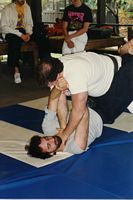
Fred Stark is teaching me a lesson at fall camp. Since I'm on top, you may at first think I'm in control. Fred has me in a body scissors, has driven my hands from his neck, and has me in a choke hold. Fred is firmly in control. In addition to earning a fifth degree black belt in TKD, Fred was a Jujitsu instructor, and I'm not sure what else. Well, he was a medical researcher too, and a wonderful soul.
Bob introduced us to Kobudo weapons training in the early eighties with Sensei Kimo Wall, also a Goju Ryu karate instructor. Initially we learned about the four basic Okinawan weapons: bo, tonfa, sai, and nunchuku. We trained at weekend seminars in Northampton, where Sensei Wall lived and taught Goju-ryu karate at UMass, a large dojo.
At our first seminar, we learned about bo, a six foot staff. We were able to acquire beautiful Okinawan red oak bos at very reasonable prices. We cared for our wooden weapons by rubbing them with linseed oil with our hands. We learned some basic bo technique and kata.
At the second seminar we reviewed bo, and we learned a little about tonfa, a stick with a handle, again made from Okinawan red oak. The third and fourth seminars brought ever more review and the introduction of the the sai, a trident shaped weapon made of steel, and nunchaku, two sticks attached by rope.
Training was a pleasure. We secluded ourselves for a weekend at a time, and practiced, practiced, and practiced. Sensei Wall has a wealth of knowledge, and he shared it with us.
Giles Hopkins, who lived in Northampton, gave up his study of Tae Kwon Do, turned his TKD school over to his senior students Gordon and Pat Bradley. Giles turned his energy to learning both Kobudo and Goju-ryu karate. Several others eventually followed, including John Jackson, Chuck Brotman, and Pete Holst. As Giles was making his transition, he was up for his third degree black-belt in TKD.
Giles was hesitant to test in TKD as he was moving on to Goju-ryu. I believe it was at the encouragement of Sensei Wall that Giles followed through with his test and was awarded his belt. Sensei Wall explained that when a master offered you recognition of accomplishment, you should accept. Sensei Wall attended the test at WTKDA Headquarters, and Giles introduced Sensei Wall to Mr. Son.
I hosted a weekend Kobudo seminar at MIT, and on another occasion, I had the pleasure of hosting Sensei Wall at my house. He was a terrific guest, dragging me outside to train. I also had the opportunity to join Sensei Wall and Giles in a visit to Mr. Anthony Mirakian's Goju-ryu Dojo in Watertown, MA, where a Tai Chi Master happened to be in town visiting.
I learned katas for bo and the katas for tonfa, sai, nunchaku, and various bunkai (two person applications), and I was offered a first degree black-belt by Sensei Wall in 1992. Although I felt very much a beginner, I accepted the lesson Sensei Wall had explained to Giles earlier, and I graciously accepted. I did not, however, keep up my kobudo training.
[Bob formed the ETKDU and moved to the firehouse: first BB test 10 June 1988.]
You are better than you think you are, but not as good as you can be. Perhaps because Bob was a school teacher, he occasionally came to class with written material entitled "Thoughts." (Please let me know if you have any copies). I continued that tradition at MIT, and wrote at least two "Thoughts" on The Whole Body and the Body Center, and Isolation and Combination.
[comraderie in the association and in the Boston area.]
[Talking to Mr. Son in Boston on the way from the airport, everything from "What is a grandmaster?" to advice on private matters.]
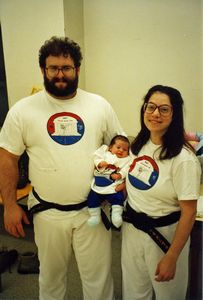

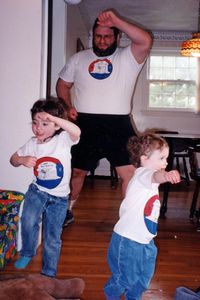 Around 1995, Debbie and I had borne our second daughter, and we had moved away from campus. Coming to class was a five hour adventure. I stopped practicing and teaching, and passed the club down to Lim, Ian, and Ron. After a few months, Ian stopped practicing and moved to CA. Ron stayed with the club for a few years, and then moved to CA where he continues to practice with the Santa Barbara club. A decade later, Lim still runs the club and has been promoted to fifth degree black-belt. There are now MIT black belts I've never practiced with. Lim has done a fine job.
Around 1995, Debbie and I had borne our second daughter, and we had moved away from campus. Coming to class was a five hour adventure. I stopped practicing and teaching, and passed the club down to Lim, Ian, and Ron. After a few months, Ian stopped practicing and moved to CA. Ron stayed with the club for a few years, and then moved to CA where he continues to practice with the Santa Barbara club. A decade later, Lim still runs the club and has been promoted to fifth degree black-belt. There are now MIT black belts I've never practiced with. Lim has done a fine job.
After I stopped practicing, Lim ran his first demo/promotion with Mr. Son. We dressed the kids and ourselves in MIT Club shirts to watch and took the above photo. Soon after, the kids, being very excited from seeing the demo, did their own demo at home, performing some basic techniques and smashing some foam kiddie toys. We have them on a video tape that I hope we can transcribe and post here.
If I were to practice martial arts again, I would look for a local teacher from whom I wanted to learn, and I'd learn whatever they had to teach. Judo and jujitsu are appealing as you get to throw people around and then hug them, and, it's called "playing," which has the right connotation. At this point, I think yoga may be the best choice once I find the time to study something new.
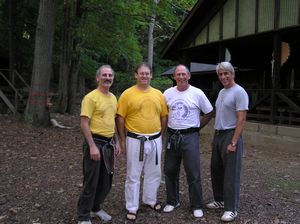
After working on these martial arts web pages in the spring and early summer of 2005, I started to reconnect with people and get psyched to revisit my roots. I called up my old friend and classmate Mark Miller, and we agreed to meet at ETKDU Fall Camp 2005.
On 13 October 2007, I had the pleasure of watching Mr. Kim preside over a class and a black-belt test at Don Massaro's studio in Port Jefferson, Long Island. It was also a pleasure to see old friends: Pete Michaelson and Jerry Orenstein. Mr. Kim travels east regularly to visit TCS schools.

In the fall of 2008, we celebrated Anne's fiftieth with many old friends, including Irwin, Peter, Chris with grown up daughters Lydia and Mary, and others.
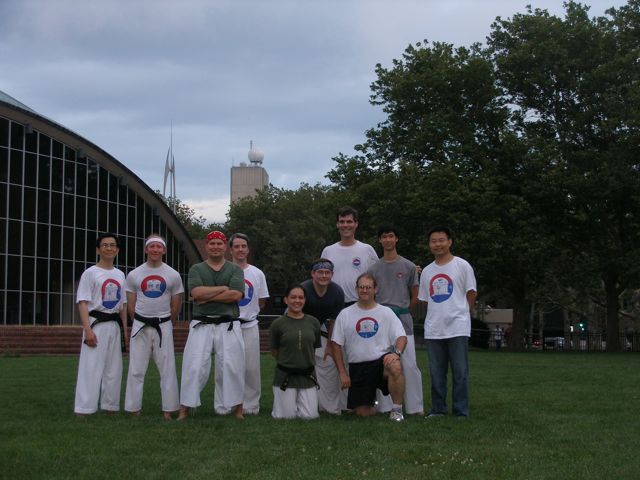
11 August 2009: I stopped by MIT class to watch Lim teach class outside Kresgee, just like the old days. Lim's been doing it all along. In the photo are: Lim, Irwin, Tim, Myles, Kendra, Dave, Peter, me, ???, and ???. Lim is now a fifth degree as is Peter; Irwin & Myles (Michael Dealy's student) are fourth degrees; Dave and Kendra (Josie McAuliffe's student) are second degrees, Tim is a first degree. Fifty of each basic, and lots of additional side kicks. Thanks to Peter for the photo.
3 April 2011: Debbie and I attended Mr. Son's wake in Newport, RI today. Mr. Son died last week. All were sad and at the same time glad to see old friends. We told stories and appreciated how Mr. Son brought us all together.

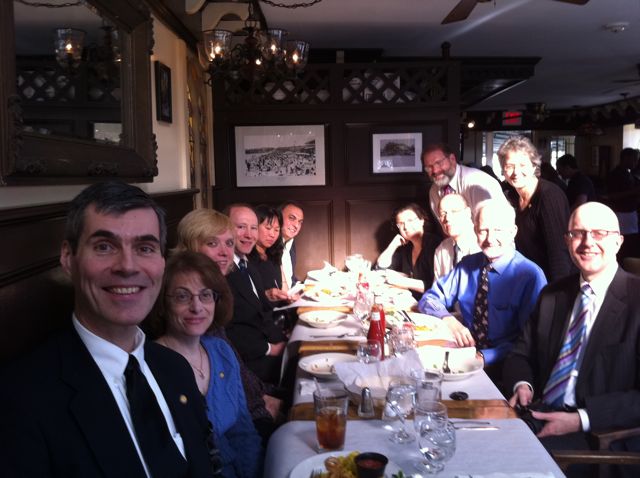
We met Lim and the MIT KKC crowd looking sharp at the funeral home: Danny, Lim, Kendra, Irena, Tim, Grace, & Anthony.
We met the Cornell/NYC gang for a snack and good memories: Peter, Deb, Anja, Irwin, Myly, Eugene, Mary, Steve, Matt, Fred, Anne, & Vernon.
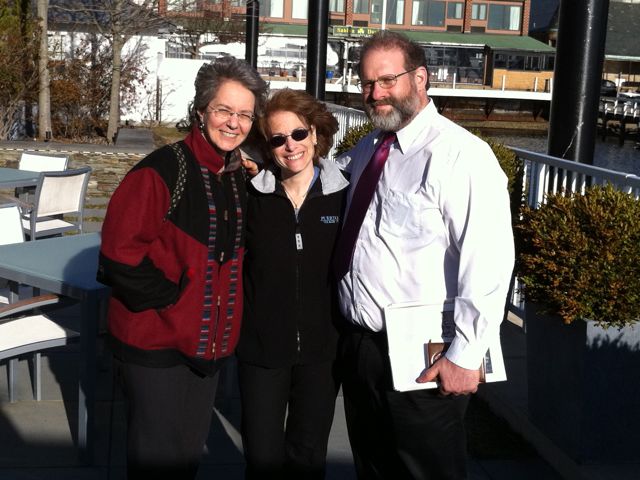

Deb, Anne, Peter, and I walked out to the water.


We met the Boston folks and Ray Mondschein for dinner.
Left: Grace, Irwin, Deb
Right: Tim, Sam, Anne
Back in my MIT days, there were plenty of Korean students around me, so I asked a friend about addressing TKD instructors in Korean. I had heard the terms: sahbom/sahbomnim as well as kwangjhang/kwangjhangnim. The honorific suffix (nim) was explained and then a calibration of the two titles. I subsequently asked Mr. Son how he should be addressed formally during the start and conclusion of class when respect is paid to the instructor, and he explained that while sabomnim mapped to instructor, and kwangjhangnim mapped to master, neither was appropriate for him. He told me that the most appropriate would be kweijhangnim, or president. I found two opportunities to use this information. First was on the rare occasions I was the senior student calling Mr. Son's class to order: kweijhangnim-gu, kyungrhe. The second opportunity was when I asked my friends to help me learn a toast in Korean that I used when Mr. Son visited MIT for a demonstration. While I can still recite the Korean (I'm sure not well), I'll stop trying to transliterate; it meant: To the President of the World TKD Association, thank you. Let's have a toast to the future of TKD. When I made the toast, Mr. Son translated it back into English. This memory was brought forward as we sat around and reminisced on Sunday. At dinner on Sunday night, I realized the same toast was still appropriate, so we raised our glasses, and I recited my memorized Korean lines to honor the memory of Mr. Son. Chukpe Hapshida.
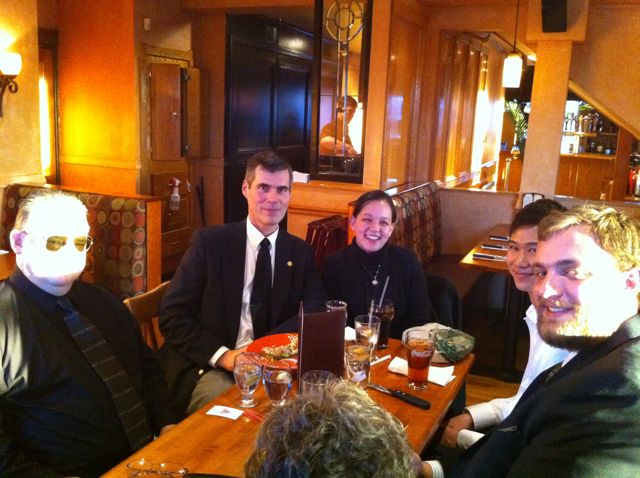
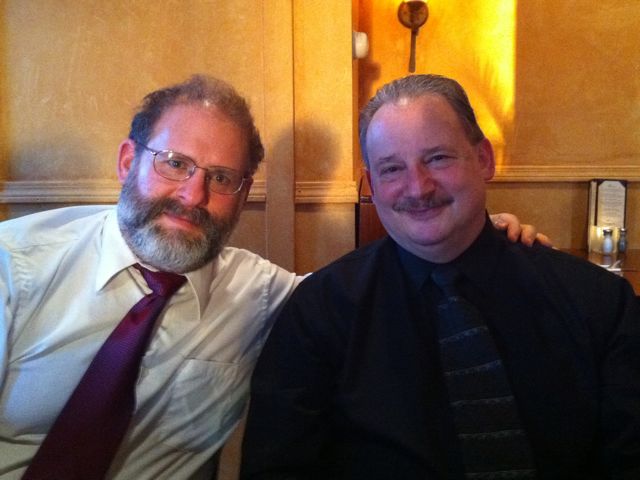
Ray: with and without the mask
Left: Sabom-mask, Peter, Kendra, Tim, Sam.
Right: Steve & Ray


Power babes: Anne & Liz. Get a load of them guns!

Me and my babe.
Martial Arts:
Steve's Story
- Timeline
- People
- Schools
- Organizations
Heller Web Space:
Images
- Notes
- Travel
- Memories
 My martial arts training started at age six or so when my dad took me to Judo class at the Poughkeepsie JCC. The instructor, Fred Margolis, ran a pretty good size club, and we took lessons for about a year until Fred moved away and the club folded. I rose to the rank of yellow belt (I don't think dad took any promotion tests) and still recall basic Judo history. At the promotion test pictured here, I'm the fellow with the shortest hair in the middle of the front row.
My martial arts training started at age six or so when my dad took me to Judo class at the Poughkeepsie JCC. The instructor, Fred Margolis, ran a pretty good size club, and we took lessons for about a year until Fred moved away and the club folded. I rose to the rank of yellow belt (I don't think dad took any promotion tests) and still recall basic Judo history. At the promotion test pictured here, I'm the fellow with the shortest hair in the middle of the front row.









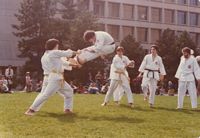






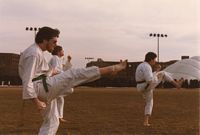
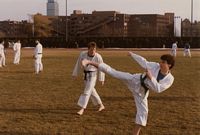
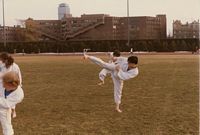
 [Mark Weiner and
[Mark Weiner and 




 Newsletters were not without precedent.
Newsletters were not without precedent. 























